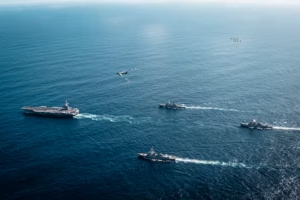The Need to Reform the Nuclear Non-Proliferation Treaty
By Kira Webster
For the past fifty years, the Nuclear Non-Proliferation Treaty has maintained nuclear peace, but without any further amendments, it may become outdated.
The 1968 treaty has drawn attention due to rising tensions of diplomacy; news of the potential U.S. withdrawal from the 1987 U.S.-Soviet Union Intermediate-Range Nuclear Forces Treaty, Russia wanting to extend the New START Treaty, and further development of nuclear weapons in Pakistan and India. Since most nuclear weapons states are adversaries, diplomats are concerned about any negative responses – especially since nuclear arms have long been used as protection.
A new UN treaty (the Treaty on the Prohibition of Nuclear Weapons) was created last year as a way to work towards nuclear disarmament in the areas that the NPT has failed. While this new treaty still needs more specifications, it has made important progress sparking important conversations about the future of nuclear arms. However, both of these treaties will be unsuccessful unless a certain level of trust between all of the Nuclear Weapons States in and out of the NPT. In order to obtain this, fluid and consistent communication is necessary. Right now, though, this would be in violation of Article 1 of the NPT: experienced nuclear states are circumspect in sharing their policies regarding command and control structures with countries that are not signed to the NPT. NWS do have mechanisms to engage in multilateral discussions concerning disarmament issues and building trust with other nations, but these only take place at NPT Review Conferences.
There are currently four known NWS outside of the NPT: Israel, India, North Korea, and Pakistan. North Korea and Israel would be the most difficult countries to include in a reformed NPT since North Korea is currently negotiating the state of its nuclear weapons program and Israel continues its policy of nuclear opacity. Without first identifying as NWS, it’s unlikely to take any action toward disarmament. On the other hand, India and Pakistan could realistically enter the NPT in the future.
India and Pakistan both have the fastest growing nuclear arsenals – developing everything from MIRV’s (Multiple Independently Targetable Reentry Vehicle, a missile containing several warheads, each capable of being aimed at a different target) to ICBM’s (Intercontinental Ballistic Missle – a missile with a minimum range of 3,400 miles, primarily designed for nuclear weapons delivery). Because of the NPT being labeled as discriminatory – a “nuclear apartheid” – no one expects either state to disarm. However, their inclusion would be crucial to attaining a peaceful future. Formally bringing them into the NPT on the pretense of both being held responsible for their arsenals, as well as being important contributors to nuclear disarmament discussions. A similar problem exists between India and China due to their unequal statuses, but they’re also unable to initiate any progressive dialogue. Maintaining bilateral and multilateral communication between both states could also help smooth over any misjudgments or concerns regarding their nuclear capabilities.
NPT Review Conferences have been discussing disarmament without representation from a quarter of the world’s nuclear-holding states. This is surely one of the biggest reasons little progress has been made towards disarmament. An amendment to expand communication strategies would be a monumental milestone in the path for banning nuclear weapon. The initial success of the NPT came from nations coming together and attempting to include everyone. The NPT must be able to be adapted to best suit the time that it’s in. An agreement can be only be strong as long as it’s relevant, and a treaty as substantial as one for nuclear proliferation can only be successful if everyone can come together.













